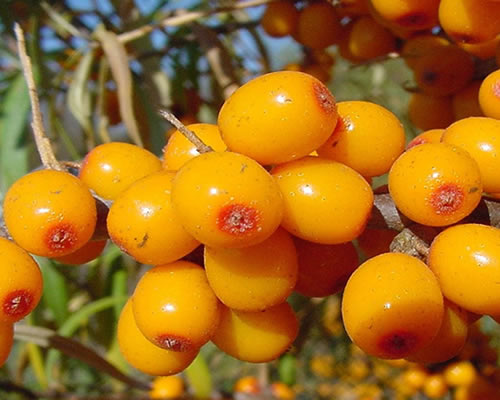Seabuckthorn
Seabuckthorn, or seaberry, originates on the coastlines of Asia, and the semi-arid areas on Mongolia and Russia.
The shrub grows to about 20 ft tall and lives for approximately 40 years. It has a very dense and thorny foliage, which makes a great habitat for birds and small mammals.
Seabuckthorn is not a leguminous tree, but it does fix nitrogen in the soil, which makes it a valuable support species in cold climates.
An 8 to 10 year old forest fixes around 165 lb per acre every year, which is a little more than your average field of clover.
The root systems are also very extensive. For example, a 5 year old plant has a tap root going down 10 feet.
An 8 to 10 year old forest fixes around 165 lb per acre every year, which is a little more than your average field of clover.
The root systems are also very extensive. For example, a 5 year old plant has a tap root going down 10 feet.
Another benefit of this tree is that it coppices well, which means that you can cut off the branches, and it will grow back quickly and vigorously. Doing so releases Nitrogen into the soil vial root self-pruning, while the stick wood has a combustion heat equivalent to oak (superior of birch and alder).
The leaf foliage of the seabuckthorn make an excellent high protein fodder for animals, while the berries are a very nutritious food for both humans and animals, making them a sought after commodity in the health food sector.
The wood is hard, and makes good firewood although I have not heard of anyone using it in woodworking.
Generally regarded as invasive in parts of Canada, it is this very nature of vigorous growth that makes it such a valuable plant in the cold climate permaculture arsenal.
This "beneficial invasiveness" translates to a short coppice / firewood cycle, meaning that more firewood can be harvested in a shorter period of time. It also means that harvesting the berries by cutting off branches is a viable option.
Seabuckthorn is a very effective animal barrier while at the same time a valuable animal shelter. It's great at keeping deer out of gardens, and young children away from potentially dangerous bodies of water.
In an industrial, mono-crop operation this plant can indeed become a problem because it's not suited to that sort of environment, however, where this plant is utilised and managed for its many beneficial properties within a highly interconnected ecosystem, then it becomes an asset.
Be it for windbreaks, erosion control, hedges, or forage, the Seabuckthorn deserves to sit near the top of not just the Canadian invasive species list, but the top of the Canadian permaculture tree species list as well.
The B.C. government published a nice fact sheet in 2001 that contains lots of good information on propagating and managing this tree.
For people looking to grow this tree, be aware that you need both male and female plants for seabuckthorn to fruit and propagate. Growing from seed is certainly possible, however you need to cold stratify them before planting.
Once you have a few trees growing, multiplying them through transplanting the numerous basal shoots, or suckers that the growing tree produces.
For people looking to grow this tree, be aware that you need both male and female plants for seabuckthorn to fruit and propagate. Growing from seed is certainly possible, however you need to cold stratify them before planting.
Once you have a few trees growing, multiplying them through transplanting the numerous basal shoots, or suckers that the growing tree produces.

No comments:
Post a Comment